Readings Newsletter
Become a Readings Member to make your shopping experience even easier.
Sign in or sign up for free!
You’re not far away from qualifying for FREE standard shipping within Australia
You’ve qualified for FREE standard shipping within Australia
The cart is loading…






Data and security breaches can cost organizations millions and result in bad publicity and lost income, with humans often being regarded as the "weakest link" in cybersecurity incidents. This book is a cross-disciplinary primer on the latest research on human aspects of cybersecurity, reimagining the role of humans in cybersecurity systems. It aims to increase participation in research on the emerging, critical, and impactful area of human factors of cybersecurity by orienting human factors researchers, professionals, and students to cybersecurity issues while providing them with comprehensive, cross-cutting knowledge from human factors that applies to this emerging area.
Across nine chapters, the Handbook of Human Factors in Cybersecurity Systems covers the essential topics for understanding humans to optimize cybersecurity system performance. Topics included cover system safety, cybersecurity teams, safety culture, cyberattacks, defence approaches, phishing, emerging cybersecurity threats and many more. The book investigates cybersecurity across numerous industries, including aviation and healthcare, and is backed up by interesting, real-life case studies. The reader will develop a full and thorough understanding of how to integrate human factors principles with cybersecurity practices.
With chapters from a team of global experts, this book is an essential read for any student, academic or professional in the disciplines of computer engineering, systems engineering, safety engineering, human factors and ergonomics and cybersecurity engineering.
$9.00 standard shipping within Australia
FREE standard shipping within Australia for orders over $100.00
Express & International shipping calculated at checkout
Stock availability can be subject to change without notice. We recommend calling the shop or contacting our online team to check availability of low stock items. Please see our Shopping Online page for more details.
Data and security breaches can cost organizations millions and result in bad publicity and lost income, with humans often being regarded as the "weakest link" in cybersecurity incidents. This book is a cross-disciplinary primer on the latest research on human aspects of cybersecurity, reimagining the role of humans in cybersecurity systems. It aims to increase participation in research on the emerging, critical, and impactful area of human factors of cybersecurity by orienting human factors researchers, professionals, and students to cybersecurity issues while providing them with comprehensive, cross-cutting knowledge from human factors that applies to this emerging area.
Across nine chapters, the Handbook of Human Factors in Cybersecurity Systems covers the essential topics for understanding humans to optimize cybersecurity system performance. Topics included cover system safety, cybersecurity teams, safety culture, cyberattacks, defence approaches, phishing, emerging cybersecurity threats and many more. The book investigates cybersecurity across numerous industries, including aviation and healthcare, and is backed up by interesting, real-life case studies. The reader will develop a full and thorough understanding of how to integrate human factors principles with cybersecurity practices.
With chapters from a team of global experts, this book is an essential read for any student, academic or professional in the disciplines of computer engineering, systems engineering, safety engineering, human factors and ergonomics and cybersecurity engineering.